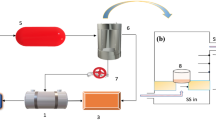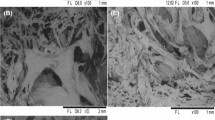Abstract
The study was aimed at determining the effect of harvesting time and drying method on the thermal and physicochemical properties of taro powder, Sosso ecotype. A 5 × 2 factorial experiment with 5 harvesting times (6, 7, 8, 9 and 10 months after planting) and 2 drying methods (sun and electric oven drying) was used for this purpose. The variance component analysis revealed harvesting time as the most important factor affecting all the variables measured. In particular the proteins and available sugar contents of the powders increased significantly with increase in harvesting time. The same was true of the gelling property and water absorption capacity of the powders. It was equally observed that the temperatures (start, peak and end) and enthalpy of gelatinization of the powders increased with harvesting time. It is concluded that harvesting sosso-taro at full maturity (10 months after planting) and sun-drying produces food powders with excellent gelling properties among others.


Similar content being viewed by others
References
AACC (1990) Approved methods of the AACC, 7th edn. American Association of Cereal Chemists, St. Paul
Abdullah EC, Geldart D (1999) The use of bulk density measurements as flowability indicators. Powder Technol 102:151–165
Aboubakar, Njintang YN, Scher J, Mbofung CMF (2008) Physicochemical, thermal properties and microstructure of six varieties of taro (Colocasia esculenta L. Schott) flours and starches. J Food Eng 86:294–305
Akingbala OJ, Falade OK, Ogunjobi AM (2011) The effect of root maturity, preprocess holding and flour storage on the quality of cassava biscuit. Food Bioproc Tech 4:451–457
Akubor PI (2005) Effects of defatting on chemical, functional and storage properties of melon (Colocynthis citrullus) seed flour. J Food Sci Tech 42:472–474
Anderson RA, Conway HF, Pfeifer VF, Griffin EL (1969) Roll and extrusion cooking of grain sorghum grits. Cereal Sci Today 14:372–380
Chotineeranat S, Suwansichon T, Chompreeda P, Piyachomkwan K, Vichukit V, Sriroth K, Haruthaithanasan V (2006) Effect of root ages on the quality of low cyanide cassava flour. Kasetsart J (Nat Sci) 40:694–701
Coffman CW, Garcia VV (1977) Functional properties and amino acid content of protein isolate from mung bean flour. J Food Tech 12:473–484
Fisher EH, Stein EA (1961) DNS colorimetric determination of available carbohydrates in foods. Biochem Prep 8:30–37
Fitzpatrick JJ, Ahrne L (2005) Food powder handling and processing: Industry problems, knowledge barriers and research opportunities. Chem Eng Process 44:209–214
Huang CJ, Lin MC, Wang CR (2006) Changes in morphological, thermal and pasting properties of yam (Dioscorea alata) starch during growth. Carbohydr Polymer 64:524–531
Jamin FF, Flores RA (1998) Effect of additional separation and grinding on the chemical and physical properties of selected corn dry-milled streams. Cereal Chem 75:166–170
Jane J, Shen L, Chen J, Lim S, Kasemsuwan T, Nip WK (1992) Physical and chemical studies of taro starches and flours. Cereal Chem 69:528–535
Karaj S, Müller J (2010) Determination of physical, mechanical and chemical properties of seeds and kernels of Jatropha curcas L. Ind Crop Prod 32:129–138
Kaur M, Singh N (2007) Relationships between various functional, thermal and pasting properties of flours from different Indian Black gram (Phaseolus mungo L.) cultivars. J Sci Food Agric 87:974–984
Kaur M, Kaushal P, Sandhu SK (2011) Studies on physicochemical and pasting properties of taro (Colocasia esculenta L.) flour in comparison with a cereal, tuber and legume flour. J Food Sci Tech. doi:10.1007/s13197-010-0227-6
Leonel M, Ferrari TB, Sarmento SBS, Oliveira MA (2005) Planting time, developmental stages and characteristics of roots and starch of Pachyrhizus ahipa. Sci Agr 62:528–533
Mbofung CMF, Aboubakar, Njintang YN, Abdou Bouba A, Balaam F (2006) Physicochemical and functional properties of six varieties of taro (Colocasia esculenta L. Schott) flour. J Food Tech 4:135–142
Njintang YN, Mbofung CMF (2003a) Kinetics of starch gelatinisation and mass transfer during cooking of taro (Colocasia esculenta L. Schott) slices. Starch-Starke 55:170–176
Njintang YN, Mbofung CMF (2003b) Development of taro (Colocasia esculenta L Schott) flour as an ingredient in food processing: effect of gelatinisation and drying temperature on the dehydration kinetics and colour of flour. J Food Eng 58:259–265
Njintang YN, Parker ML, Moates GK, Mbofung CMF, Smith AC, Waldron KW (2006) Rheology and microstructure of achu, a food based on taro (Colocasia esculenta L. Schott), as affected by method of preparation. J Sci Food Agric 86:902–907
Njintang NY, Mbofung CMF, Kesteloot R (2007a) Multivariate analysis of the effect of drying method and particle size of flour on the instrumental texture characteristics of paste made from two varieties of taro (Colocasia esculenta L. Schott) flour. J Food Eng 81:250–256
Njintang YN, Mbofung CMF, Moates KG, Parker L, Fauld CB, Smith AC (2007b) Functional properties of five varieties of taro flour and relationship to creep recovery and sensory characteristics of achu (taro based paste). J Food Eng 82:114–120
Njintang NY, Parker ML, Moates GK, Faulds CB, Smith AC, Waldron KW, Mbofung CMF, Scher J (2008) Microstructure and creep-recovery characteristics of achu (a taro based paste) made from freeze dried taro chips as affected by moisture content and variety. J Food Eng 87:172–180
Noda T, Takahata Y, Nagata T (1992) Developmental changes in properties of sweet potato starch. Starch-Starke 44:405–409
Noda T, Takahata Y, Sato T, Ikoma H, Mochida H (1996) Physicochemical properties of starch from purple and orange fleshed sweet potato roots at two levels of fertiliser. Starch-Starke 48:395–399
Peng M, Gao M, Abdel-Aal E-SM, Hucl P, Chibbar RN (1999) Separation and characterization of A- and B- type starch granules in wheat endosperm. Cereal Chem 76:375–379
Phillips RD, Chinnan MS, Branch AL, Miller J, Mcwatters KH (1988) Effects of pre-treatment on functional and nutritional properties of cowpea meal. J Food Sci 53:805–809
Sagar VR, Suresh Kumar P (2010) Recent advances in drying and dehydration of fruits and vegetables: a review. J Food Sci Tech 47:15–26
Schmidt RH (1981) Gelation and coagulation. In: Protein functionality in foods, ACS symposium series 147 Ed. Cherry J.P. Washington, DC, pp. 131–147
Sefa-Dedeh S, Agyir-Sackey EK (2004) Chemical composition and the effect of processing on oxalate content of cocoyam Xanthosoma sagittifolium and Colocasia esculenta cormels. Food Chem 85:479–487
Singh U (2001) Functional properties of grain legume flours. J Food Sci Tech 38:191–199
Singh U, Sagar VR, Behera TK, Kumar PS (2006) Effect of drying conditions on the quality of dehydrated selected vegetables. J Food Sci Tech 43:579–582
Tattiyakul J, Pradipasena P, Asavasaksakul S (2007) Taro Colocasia esculenta (L.) Schott amylopectin structure and its effect on starch functional properties. Starch-Starke 59:342–347
Yahya MG, Yahya SA, Faiz KB (2000) Preservation of fruits and vegetables using solar drier: a comparative study of natural and solar drying, III; chemical analysis and sensory evaluation data of the dried samples (grapes, tomatoes and onions). Renew Energ 19:203–212
Acknowledgment
The authors wish to thank the Cooperation pour la Recherche Universitaire (CORUS) for financial support.
Author information
Authors and Affiliations
Corresponding author
Rights and permissions
About this article
Cite this article
Himeda, M., Njintang, Y.N., Gaiani, C. et al. Physicochemical and thermal properties of taro (Colocasia esculenta sp) powders as affected by state of maturity and drying method. J Food Sci Technol 51, 1857–1865 (2014). https://doi.org/10.1007/s13197-012-0697-9
Revised:
Accepted:
Published:
Issue Date:
DOI: https://doi.org/10.1007/s13197-012-0697-9




